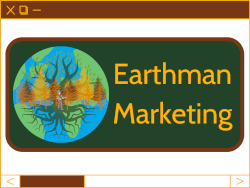Navigating the Future of Search: A Comprehensive Guide to Search Everywhere Optimization for Small Businesses
October 20th, 2025
For years, the playbook for getting found online was simple: rank high on Google. As a small business owner, you probably spent a lot of time on traditional SEO, and for good reason—it worked! But the digital landscape is changing fast. Your customers are no longer just using Google; they’re searching on TikTok, asking AI assistants for recommendations, and discovering new things on Instagram.
This evolution is the dawn of Search Everywhere Optimization, and it’s reshaping what effective digital marketing services look like. It’s no longer enough to master a single search engine; the goal now is to be visible wherever your audience is looking. At Earthman Marketing, we’ll break down exactly what this means for your business and provide a clear roadmap to ensure your brand doesn’t just survive the future of search, but thrives in it.
In this guide: we explain:
What Is Search Everywhere Optimization and How It Differs from Traditional SEO
To start, Search Everywhere Optimization is not a replacement for traditional SEO by any means. Normal SEO is still here and should continue to be worked on. If Search Everywhere Optimization were a cooking recipe, SEO would simply be one of the ingredients.
Traditional SEO primarily focuses on enhancing a website’s visibility and its rankings in search engines like Google and Bing. Search Everywhere Optimization broadens this scope. It’s a strategy designed to ensure a brand’s content and presence are discoverable across every digital platform where people seek information.
How is Search Everywhere Optimization Different?
The fundamental difference lies in the areas of focus.
Let’s Refresh on Traditional SEO
Traditional SEO largely concentrates on a combination of both on-page and off-page elements. These on-page elements include things such as:
- Keyword optimization
- Content quality, relevance, & optimization
- Proper page structure, such as:
- Optimized meta tags
- Schema markup
- Headings
- Image optimization
- User experience (UX) factors like:
- Page loading speed
- Mobile friendliness
- Readability
Off-page elements include the following:
- Backlinks
- Online reviews
- Social media engagement
- While not directly related, high engagement leads to more visibility.
Now What About Search Everywhere Optimization
In contrast, Search Everywhere Optimization considers how content is indexed and presented across multiple platforms. These platforms include:
- Social media
- AI searches
- E-commerce marketplaces
- Voice search
- Niche communities
- This can be anything from Subreddits, LinkedIn Groups, Industry-related forums, etc.
The goal is to make a brand discoverable wherever its audience searches, rather than relying on a single search destination.
Why Search Everywhere Optimization Is Critical for Small Businesses
This expanded focus is critical because user journeys to discovering a business or brand are increasingly becoming fragmented. For example, a large group of Gen Z’ers prefer searching on platforms like TikTok or Instagram over traditional search engines.
Moreover, AI search platforms like ChatGPT are altering how people discover content and influencing how they consume information. These platforms source their information online but decide what to display depending on whether it makes sense in context, among other things. As a result, AI search continues directing users to various websites daily, acting as an important source of traffic.
The Important Part
Search Everywhere Optimization aligns a brand with how each of these platforms processes and surfaces information. What this means is that there is no longer a universal playbook for search visibility.
A crucial element underpinning Search Everywhere Optimization is the concept of “entities.” These are the clearly defined and recognizable elements associated with a business, such as:
- Brand/Business name
- Key people
- Specific products
- Core concepts
This consistency helps various platforms understand who the business is, what it offers, and its position within its industry. The more consistently a brand appears across platforms (semantically, structurally, and contextually), the more likely it is to be found. Even when not explicitly searching for it by name. When thinking about the future, Search Everywhere Optimization must be part of any business’s digital strategy.
How to Optimize for Search Everywhere Optimization: Key Factors and Strategies
Optimizing for Search Everywhere Optimization extends traditional SEO principles to a broader digital ecosystem. It involves tailoring content and presence to the unique algorithms and user behaviors of various platforms.
1. Traditional Search Engines (Google, Bing): The Foundation
Optimizing for platforms like Google and Bing remains a foundational component. These search engines continue to drive significant traffic and establish online authority. An effective SEO framework should focus on the following:
Keyword Research and Integration:
Identifying the terms and phrases your target audience uses is crucial. Long-tail keywords often indicate clear user intent and can lead to higher rankings for specific queries, and should be prioritized. These keywords should naturally integrate into your content, avoiding “keyword stuffing,” which can negatively impact rankings.
User Experience (UX) and Technical SEO:
Google heavily considers user experience when ranking sites. This includes:
- Fast page loading times
- Intuitive website navigation
- Mobile responsiveness
A positive user experience encourages longer times spent on site, signaling relevance to search engines.
Content Quality and Value:
Publishing valuable, high-quality content is crucial for driving traffic and increasing time on site. Content should be well-researched, informative, and engaging, directly addressing user needs and queries.
On-Page Optimization:
Meta tags should be optimized as they are the first elements users see on a search results page. Include your most important keywords at the beginning of your title tags to make a strong impression and indicate relevance. Meta descriptions, the small blurb below the title, should be compelling and summarize the page’s content effectively.
Internal Linking and Image Tagging:
Strategically link to other relevant pages on your website, as this helps improve navigation and distribute link equity. Be sure to include that page’s keyword phrase as the link’s anchor text. Additionally, tag images with descriptive alt text to improve accessibility and provide additional context for search engines.
Building Authority through Backlinks and Earned Media:
High-quality backlinks from authoritative and credible sources are vital for signaling trustworthiness to search engines. Earned media, like reviews or PR opportunities, are highly valuable for the same reason as high-quality backlinks. However, PR opportunities often come with backlinks from sites with high domain authority, making it more compelling.
2. Social Media Search (Instagram, TikTok, LinkedIn): Visual & Community-Driven Discovery
Social media platforms like Facebook and Instagram are no longer just for sharing a person’s life. They now also function as search engines where users actively seek information, products, and trends. As a result, optimizing for these channels is a key part of Search Everywhere Optimization.
Optimizing Captions with Intent-Driven Keywords:
It’s important to note that social media platforms use keyword-based search algorithms. That means captions, titles, and descriptions should reflect a natural, shorter, and question-based language that users employ in social searches. Prioritize these key phrases at the beginning of captions, as they are often truncated.
The approach here is to think like your audience. Consider phrases they may type into the search bar to find content, and then incorporate those phrases naturally.
Using Strategic Search-Driven Hashtags:
Hashtags remain important for discoverability, but their selection should be based on search behavior rather than just trending topics. An effective method is to mix both broad and targeted hashtags (e.g., #BeginnerWorkoutTips or #StrengthTrainingForWomen).
Analyzing competitor or influencer hashtags and checking search volume can enhance visibility. A hashtag with medium traffic is ideal, as are location-based hashtags, being valuable for local reach.
Prioritizing and Optimizing Short-Form Video Content:
As human attention spans unfortunately continue to grow shorter and shorter, the popularity of short-form videos will continue to rise. Platforms like TikTok, Instagram Reels, and YouTube Shorts heavily prioritize short-form video content.
Even though these platforms likely contribute to the shortening of human attention spans, they’re great for engagement. High engagement on social media platforms leads to increased social exposure.
Engaging with User-Generated Content and Community:
The largest benefit of having a social media presence is engaging with your customers. Actively responding to comments, sharing user-generated content, and creating interactive posts helps to foster a vibrant community. This engagement not only enhances trust, credibility, and visibility but also provides positive signals to social algorithms.
3. AI-Driven Search (ChatGPT, Google Gemini & AI Overviews): The Conversational Frontier
The advent of AI is transforming how content is discovered and consumed. Users increasingly rely on AI-generated summaries and direct answers rather than browsing traditional search results.
Crafting Content Ideal for AI Summarization and Direct Answers:
Focus on producing concise, high-quality, and highly informative content that directly answers user queries. Your content should be clear, logical, and in a digestible manner that AI models can easily interpret, extract, and summarize. This helps to make your content more suitable for featured snippets and AI overviews.
Focusing on Natural Language Queries and Conversational Tones:
AI-driven search engines are designed to interpret complex, natural language questions, moving beyond simple keyword matching. Therefore, your content should be optimized to how users verbally seek information. Content should incorporate conversational language and full questions rather than just fragmented keywords.
Optimizing for User Intent in AI-Powered Results:
The end goal is to provide the exact, most relevant information users need. This significantly increases the likelihood of content being featured as a direct answer or in an AI summary. To do this, it requires understanding a user’s intent and anticipating the specific questions a target audience is asking.
4. Shopping Platforms (Amazon, Etsy, Shopify): Product Discoverability & Sales
While e-commerce platforms, in their most general view, are simply online storefronts. They can also be seen in a more technical view as specialized search engines for product discovery. In order to optimize for these platforms, a distinct approach is required compared to general web search.
Optimizing Product Listings with Detailed Descriptions, High-Quality Images, and Rich Attributes:
Provide full, detailed descriptions that highlight key features, unique benefits, and precise specifications of products. Make sure products are accompanied by high-quality images showcasing them from various angles, in different contexts, and clearly visible.
On top of that, carefully fill out all available product attributes (e.g., size, color, material, category, compatibility). Online marketplaces rely on this structured data to accurately match products to buyer queries.
Utilizing Marketplace-Specific Keywords and Backend Search Terms:
It’s good to note that people search differently on platforms like Amazon or Etsy than they do on Google. Research and incorporate high-intent keywords that buyers specifically use when looking for products on these marketplaces. Be sure to leverage any backend search terms or hidden keyword fields provided by the platforms to capture additional relevant queries.
Improving Internal E-commerce Search Functionality for Seamless Customer Journeys:
For a business’s own Shopify store or custom e-commerce website, ensure the internal search is intuitive and user-friendly. Adding advanced filters and quick results helps users navigate through products more fluidly, helping improve the user experience.
Encourage Reviews and Competitive Pricing:
Actively encourage customers to leave reviews, as positive reviews are crucial for building trust and influencing product rankings on marketplaces. While not directly an optimization tactic, pricing competitively can also encourage more clicks and purchases, signaling popularity to platform algorithms.
5. Voice Search (Alexa, Google Assistant, Siri): The Spoken Word
The escalating adoption of voice-activated searches and smart assistants makes optimizing for these platforms an increasingly crucial component of Search Everywhere Optimization. Siri sources its information from Apple Maps, so be sure you have an Apple Business Connect profile created in addition to Google.
Tailoring Content and Descriptions for Voice Assistant Responses:
Content and product descriptions should be designed to directly answer common voice queries. The goal is to have your business be displayed when users ask about relevant products or services.
Adapting to Natural, Conversational Language Queries:
Voice search inherently utilizes natural, conversational language, as users speak their queries rather than typing them. Therefore, like AI search, content should reflect a conversational tone and be optimized to align with how users verbally seek information.
Ready to Master Search Everywhere Optimization? 🚀
As you can see, showing up everywhere your customers are looking is the key to future-proofing your small business. It’s not just about being on Google anymore; it’s about creating a seamless presence across every platform, from social media to AI assistants.
If you’re ready to stop worrying about being seen and start building a brand that’s truly everywhere, connect with Earthman Marketing. We’ll help you create a strategy that puts your business on the map—literally. Don’t wait for your customers to find you; meet them where they are.





